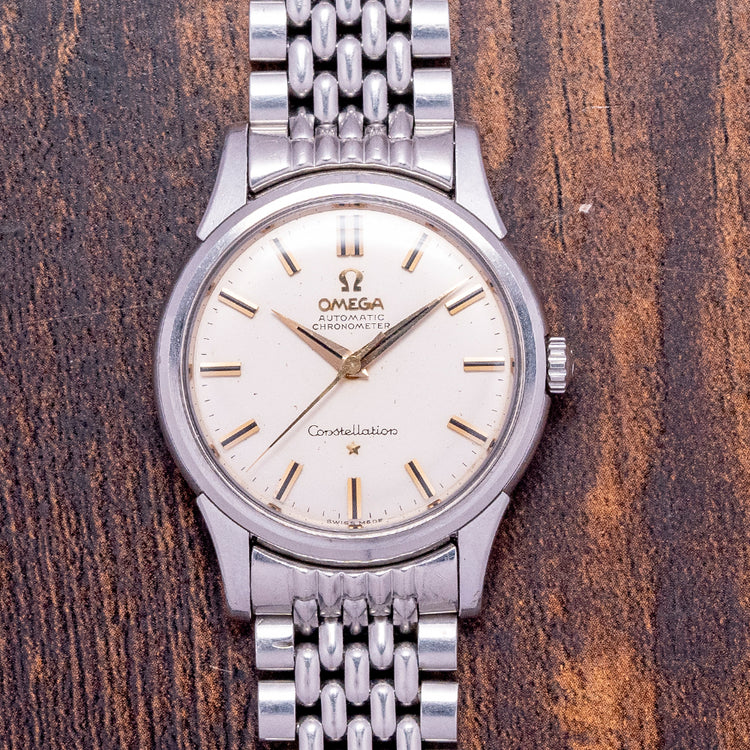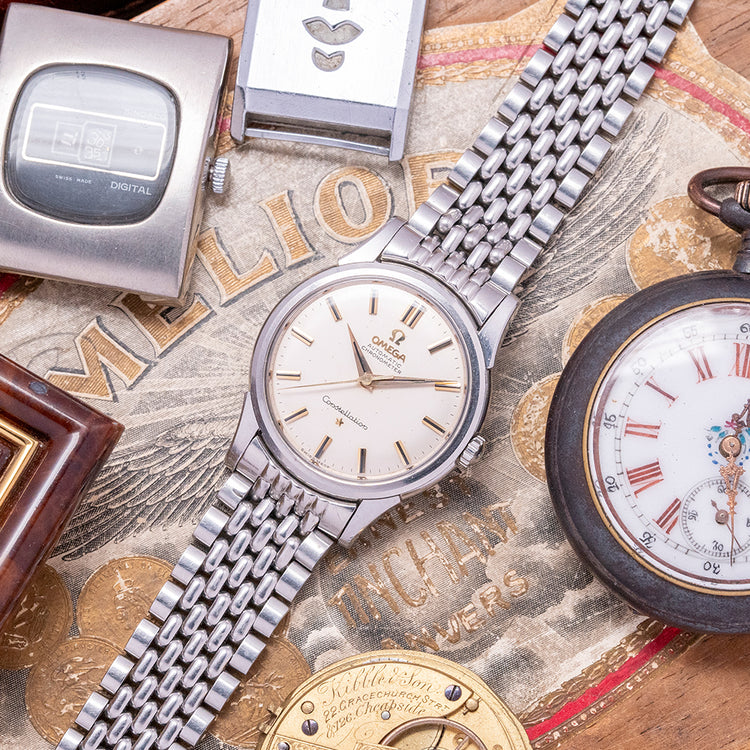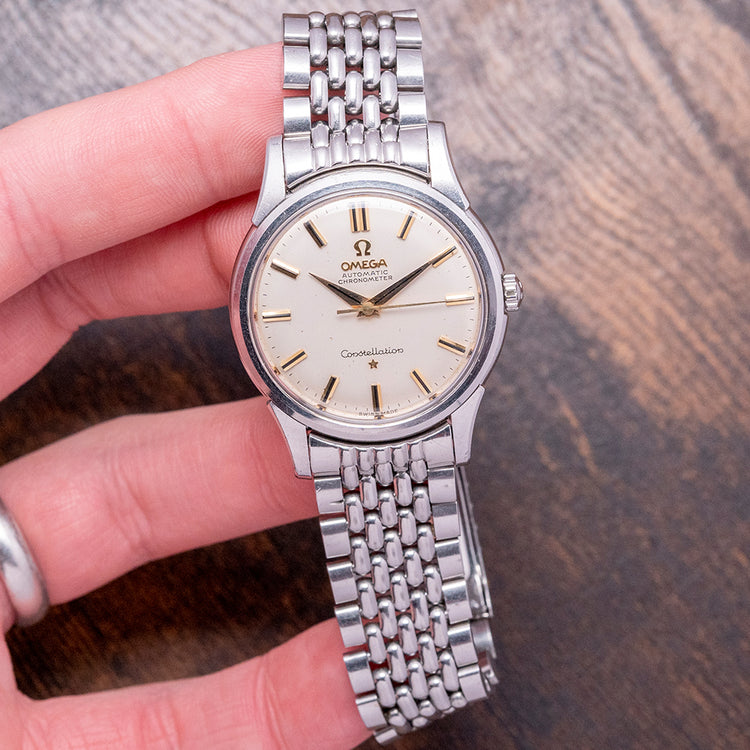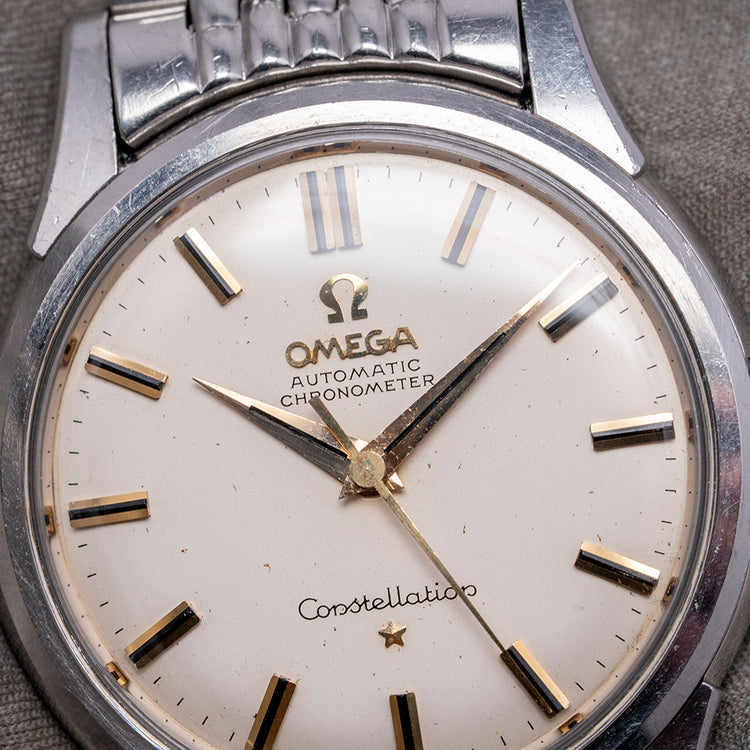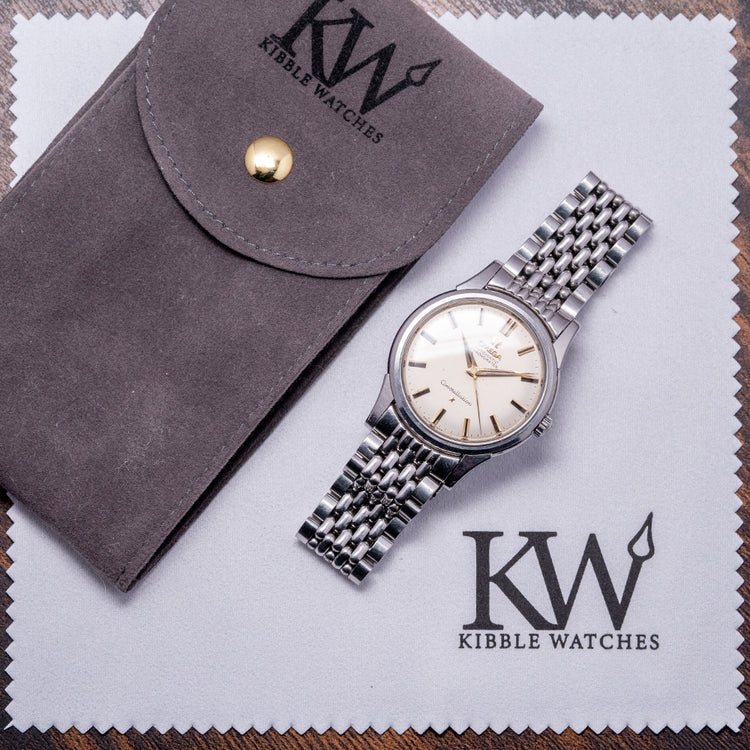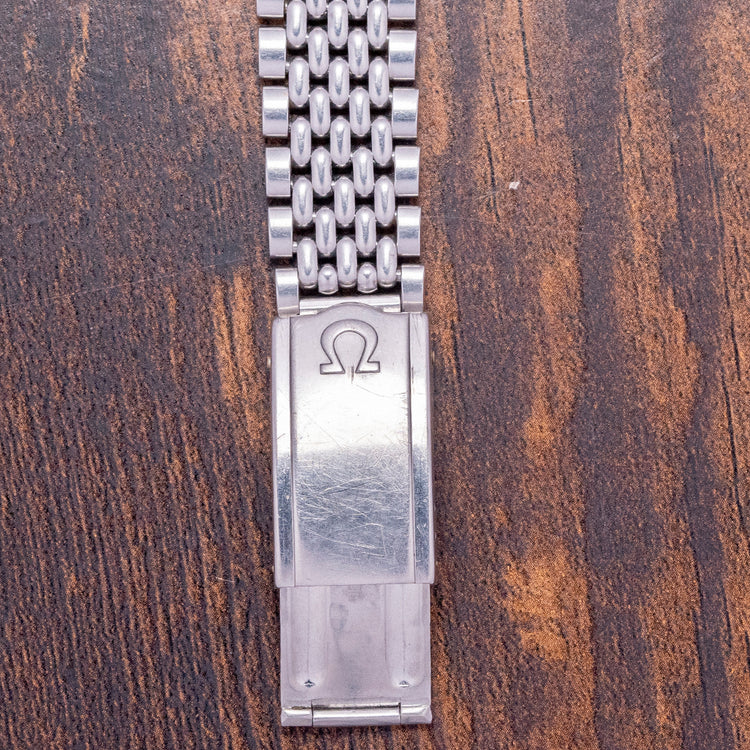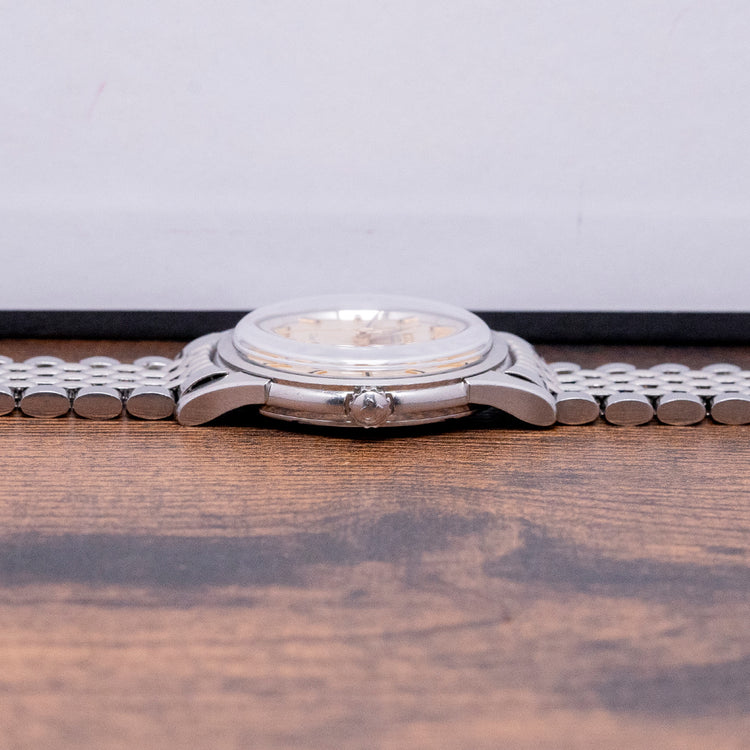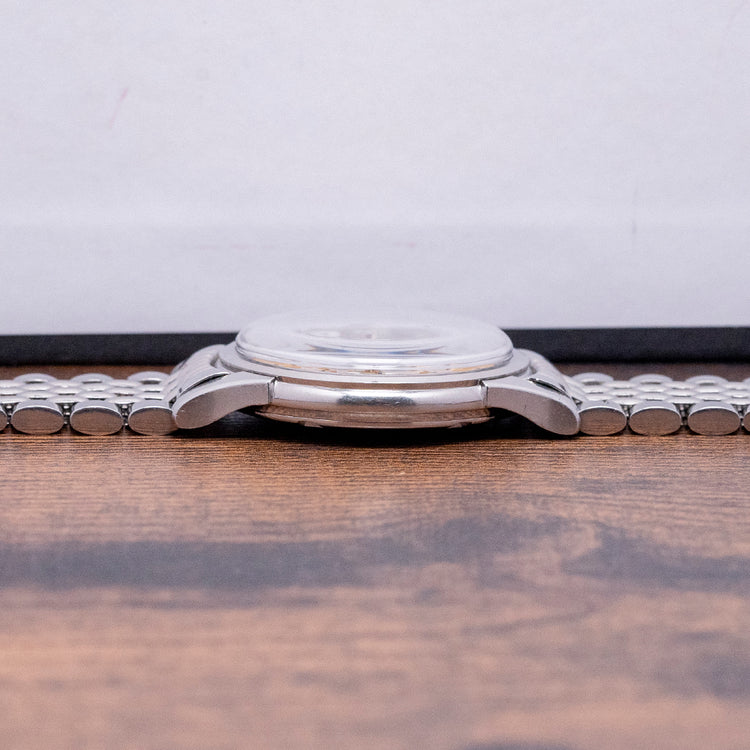More Information
Description
More
Less
More
Less
Here we have a 1960 Omega Constellation Automatic 14381 with a curvaceous 34.5mm, stainless steel case, a lug-to-lug length of 43.5mm with gently curved, tapered dog leg lugs, and a case thickness of 10mm ensures a comfortable fit on your wrist. On the right side, there is a signed push/pull crown. A smooth bevel-edged bezel holds the domed crystal above a stunning off-white dial with an outer minute track and chamfered applied gold baton indexes, onyx-filled centres marking the hours. The Gold Dauphine hands have onyx infill complemented by a tapered centre second hand, completing the attractive dial. Text is precisely printed at 12 with an applied gold Omega motif “Automatic Chronometer” and 6 “Constellation” and applied gold “Star”. On the reverse, a screw-down case back with a well-worn embossed Observatory and stars in the centre. Inside an automatic Omega Cal. 551, 24 jewels, 19,800 beats per hour, it comes paired with its original Omega 18mm “Beads of Rice” stainless steel bracelet secured by a signed folding clasp, which will fit up to a 7.4-inch wrist.
Points of Mention
More
Less
More
Less
This watch is sold as "Watch Only", meaning it comes with no original Omega box or original Omega paperwork. It comes paired with its original Omega 18mm “Beads of Rice” stainless steel bracelet secured by a signed folding clasp, which will fit up to a 7.4-inch wrist. The watch is from Circa. 1960, in original and unpolished condition, the case features signs of wear with a few marks here and there, as it was worn daily for many years. The rear medallion has worn down from wear. The dial has developed a soft and even patina all over, as you can see. The watch comes with our 12-Months NON-Waterproof warranty.
Personal Note
More
Less
More
Less
This watch had been sat in a draw for 10+ years before finding its way to me from the original family, it arrived with paint on it and a large build up all over from years and years of wear, but you could easily see this watch had never been polished and the dial would be beautiful under the scuffed and paint riddled crystal. Our watchmaker worked his magic, and here we are, with a beautiful Constellation from 1960 on its beads of rice bracelet, ready to be worn and enjoyed again. The watch is unpolished and features its lovely, sharp dog leg lugs and crisp bevels, though from daily use for many, many years, the gold observatory medallion on the case back has naturally worn down. It's little details like these that draw me to vintage so much as it all becomes part of its story, one that can live on for another 65 years. Add this vintage gem to your collection today!
Specification
More
Less
More
Less
Reference : 14381 7 SC
Movement : Automatic Omega Cal. 551
Age : Circa. 1960
Year : 1960
Case Size : 34.5mm
Case Thickness : 10mm
Lug to Lug : 43.5mm
Lugs : 18mm
Condition : Pre-Owned
Box and Papers : None
Case Material : Stainless Steel
Warranty : 12 Months NON-Waterproof Warranty
The wrist model's wrist size is 7inch
Movement : Automatic Omega Cal. 551
Age : Circa. 1960
Year : 1960
Case Size : 34.5mm
Case Thickness : 10mm
Lug to Lug : 43.5mm
Lugs : 18mm
Condition : Pre-Owned
Box and Papers : None
Case Material : Stainless Steel
Warranty : 12 Months NON-Waterproof Warranty
The wrist model's wrist size is 7inch
About Omega
More
Less
More
Less
They were formerly known as the La Generale Watch Co., founded in 1848 by Louis Brandt in La Chaux-de-Fonds. When he died in 1879, his sons carried on his dream. In 1880, they moved to 96 Rue Jakob-Stampfli, where they remain today. The brothers produced their first mass-produced calibre, the Labrador In 1885. Just a few years later, in 1892, they produced the first minute-repeater. In 1903, they renamed the company Omega until 1982, when they officially changed their name to Omega SA. During WW1, Omega watches were used as official timekeepers for the Royal Flying Corps and the US Army. In 1930, Omega and Tissot merged together to form Société Suisse pour l'Industrie Horlogère (SSIH). In 1931, another group was formed - Allgemeine Schweizerische Uhrenindustrie AG (ASUAG). Where SSIH was primarily French-speaking, ASUAG was founded by the more German-speaking members of the Swiss watch industry. In 1948, they introduced the first edition of one of their most symbolic watches: the Seamaster. Omega first introduced the Constellation in 1952. At the time, it was Omega's flagship timepiece. The first models had a Cal. 354 bumper movement in them. Later in 1955, Omega introduced the Automatic Cal. 50x, followed in 1959 by the Cal.. 55x (no date) and 56x (date) versions. Many of the Constellations came with pie-pan dials, diamond indexes, and fancy lug configurations. All the gold Constellations of that time have the Observatory of Geneva's hand engraved on the back. The stainless steel and stainless steel/gold versions had a gold medallion on the back with the Observatory of Geneva. The eight stars above the Observatory stand for the many exploits of Omega in the world Chronometer competition. Celebrating the fact that all Constellations are Chronometer Certified. In 1962, when astronaut Wally Schirra wore a Speedmaster on his Mercury Sigma 7 Mission, making it the first Omega watch to enter space. After rigorous tests, NASA used Omega for all their Apollo missions, including the 1969 Moon landing of Apollo 11. Today Omega is still an astronaut's first choice. In 1969, President Nixon famously said it was “too valuable” and turned down the first-ever all-gold Speedmaster Professional Deluxe. As a response to the ever-growing threat of electronic watches to the manufacturers of mechanical watches, Omega and many Swiss brands such as Rolex and Patek Philippe formed Centre Electronique Horologer (CEH). Prototypes began to appear in 1967 with their production starting in 1968. Then In 1972, Omega introduced the reference, 198.030, which included the Omega calibre 1250, a ‘tuning-fork electronic movement which was made under licence from Bulova. Later we saw a merger of SSIH and ASUAG into SMH, or Société de Microélectronique et d’Horlogerie. This merger took place in 1983. In 1992, the company acquired Blancpain, and in 1998 it officially rebranded itself from SMH to the Swatch Group. Then, in 1999, they purchased and integrated Breguet into the Swatch Group.
Description
Here we have a 1960 Omega Constellation Automatic 14381 with a curvaceous 34.5mm, stainless steel case, a lug-to-lug length of 43.5mm with gently curved, tapered dog leg lugs, and a case thickness of 10mm ensures a comfortable fit on your wrist. On the right side, there is a signed push/pull crown. A smooth bevel-edged bezel holds the domed crystal above a stunning off-white dial with an outer minute track and chamfered applied gold baton indexes, onyx-filled centres marking the hours. The Gold Dauphine hands have onyx infill complemented by a tapered centre second hand, completing the attractive dial. Text is precisely printed at 12 with an applied gold Omega motif “Automatic Chronometer” and 6 “Constellation” and applied gold “Star”. On the reverse, a screw-down case back with a well-worn embossed Observatory and stars in the centre. Inside an automatic Omega Cal. 551, 24 jewels, 19,800 beats per hour, it comes paired with its original Omega 18mm “Beads of Rice” stainless steel bracelet secured by a signed folding clasp, which will fit up to a 7.4-inch wrist.
Points of Mention
Personal Note
Specification
The Brand
Enquire or Book an Appointment
Would you like to discover further details about this watch, or perhaps arrange an appointment to view and try it on? Complete this form and a member of our team will get back to you shortly.
You May Also Like


























